At Fuji Speedway, we had the opportunity to have a lengthy talk with GTA chairman Masaaki Bandoh about the first ever Dream Race between Super GT and DTM, the next generation GT500 cars, the JAF-GT300 MC platform as well as his plans and dreams for the future.
As a German website, our articles are usually written in German. However, with the international interest in mind, we decided to publish this article in English.
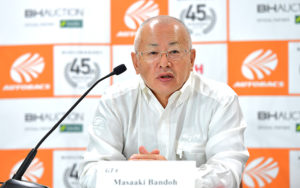 History has been made: On November 23rd and November 24th, the Japanese Super GT championship and German DTM series joined forces for its first ever joint event. The Dream Race saw seven cars in total from Audi and BMW making the long trip to Fuji Speedway in Japan, where they went head-to-head with the 15 GT500 machines of Lexus, Honda and Nissan. It’s been a dream long time in the making. Just a few hours before the starting signal turned to green for the first ever clash between two of the most popular international sportscar and touring car series, we sat down with GTA chairman Masaaki Bandoh.
History has been made: On November 23rd and November 24th, the Japanese Super GT championship and German DTM series joined forces for its first ever joint event. The Dream Race saw seven cars in total from Audi and BMW making the long trip to Fuji Speedway in Japan, where they went head-to-head with the 15 GT500 machines of Lexus, Honda and Nissan. It’s been a dream long time in the making. Just a few hours before the starting signal turned to green for the first ever clash between two of the most popular international sportscar and touring car series, we sat down with GTA chairman Masaaki Bandoh.
“We, the GT Association (GTA), started talking with the ITR about the same technical regulations in 2010, with the idea to reduce the costs as well as globalization on both sides. This is now known as Class 1, where we’re trying to make the same regulations for both sprint and endurance type cars.” Super GT was the first of the two parties to adapt the first version of the Class 1 regulations in 2014, when its premier GT500 class introduced the common monocoque and new 2.0-liter turbo engine formula, which is known as the Nippon Race Engine (NRE) in Japan. Plans for a joint event have been articulated multiple times over the years. However, things slowed down a little bit since 2014, as DTM delayed the introduction of the same turbo engine formula due to concerns about the costs by Mercedes, who would later leave the series after the 2018 season. “DTM was a little bit slow on the engine side”, Masaaki Bandoh admits. “However, since they introduced the 2.0-liter turbo engines this year, we were finally able to realize this Dream Race.”
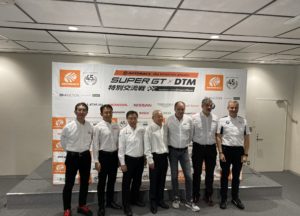 Fuji Speedway wasn’t the first time that Super GT and DTM shared the same track. Back in 2017, Lexus and Nissan came to Hockenheim for demonstration laps, giving the German fans a first taste of the fast GT500 machines. Just one month later, the DTM manufacturers followed the invitation to do the same at the Super GT season finale in Motegi. It was an important sign that showed unity and willingness to move forward with the Class 1 regulations. Just half a year later, both Masaaki Bandoh and ITR chairman Gerhard Berger presented the now finalized Class 1 regulations at Nuremberg – and with it the announcement for the first ever Dream Race at Fuji Speedway.
Fuji Speedway wasn’t the first time that Super GT and DTM shared the same track. Back in 2017, Lexus and Nissan came to Hockenheim for demonstration laps, giving the German fans a first taste of the fast GT500 machines. Just one month later, the DTM manufacturers followed the invitation to do the same at the Super GT season finale in Motegi. It was an important sign that showed unity and willingness to move forward with the Class 1 regulations. Just half a year later, both Masaaki Bandoh and ITR chairman Gerhard Berger presented the now finalized Class 1 regulations at Nuremberg – and with it the announcement for the first ever Dream Race at Fuji Speedway.
Just a month before their first ever joint event, Honda, Lexus and Nissan entered the DTM season finale at Hockenheim. It was a prelude to bigger things to come. Bad weather, the inexperience with the Hankook control tyre used in the Deutsche Tourenwagen Masters as well as not having DRS and push-to-pass turned the weekend into a tough affair for the Japanese guests, though. Especially the wet Hankook tyres turned out to be an Achille’s heel for the GT500 machines, who had to deal with zero grip after not being able to get the necessary heat into them. With Super GT adopting the new Class 1 regulations in 2020, which will be known as Class 1 + α in Japan, because of minor modifications necessary due to the different race format (endurance racing, driver changes etc.), this year’s GT500 and DTM cars were still a bit different going into Fuji.
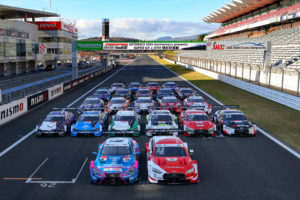 How come that they were still able to fight on equal terms then? Masaaki Bandoh explains: “The GT500 cars are developed with the idea of high downforce and high grip tyres. However, the top speed at the end of the main straight is almost the same for both DTM and GT500 machines. For this race, the DTM cars have a higher ground clearance and a less downforce set-up. That is why the top speed is almost the same between both cars. The corner speed of both cars is almost the same as well, which means that less downforce and higher road clearance cars can be equal and compete with the high downforce and less road clearance cars in the cornering. That means that the German cars aren’t developed on the same basic idea as the Japanese ones. But due to the mentioned changes, they can compete against each other.”
How come that they were still able to fight on equal terms then? Masaaki Bandoh explains: “The GT500 cars are developed with the idea of high downforce and high grip tyres. However, the top speed at the end of the main straight is almost the same for both DTM and GT500 machines. For this race, the DTM cars have a higher ground clearance and a less downforce set-up. That is why the top speed is almost the same between both cars. The corner speed of both cars is almost the same as well, which means that less downforce and higher road clearance cars can be equal and compete with the high downforce and less road clearance cars in the cornering. That means that the German cars aren’t developed on the same basic idea as the Japanese ones. But due to the mentioned changes, they can compete against each other.”
But it wasn’t just the necessary set-up changes. Another key factor were the drivers themselves: “All of this can be realized thanks to the drivers’ skills as well as the mechanical grip of the cars. The German teams and pilots are used to set-ups with low grip tyres and their driving technique is aimed at having high cornering speed, even though their tyres don’t have enough grip. From this point of view, the Japanese teams aren’t as good as the German ones. For the majority of the Japanese teams, this is the first time they’re using the Hankook tyres, which isn’t on the same level as the ones used in GT500 in terms of grip. However, they’re trying their best to set up the car with the Hankook tyres in a very short amount of time, which is a great job by them.” The Dream Race got eventually swept by the Super GT stars, with victories by Nick Cassidy (KeePer TOM’s LC500) and Narain Karthikeyan (Modulo Epson NSX-GT) respectively. While the competition between the two series was definitely one of the main aspects, it wasn’t the focus of the weekend. “The most important thing for this Dream Race is to learn together, to race together with Super GT and DTM, with the same technical regulations. We realized it this weekend, which is great for both sides.”
No concrete plans for another Dream Race just yet. A possible winter series in the future?
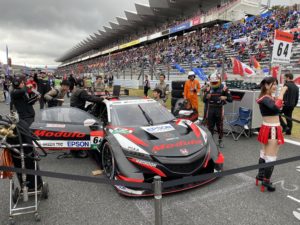 The event itself was a complete success, both in fan reaction and in entertainment on track. However, according to DTM boss Gerhard Berger, it also showed that there are “still some problems on the table, which we need to work on.” One of those problems could be the costs, putting a question mark behind future Dream Races or even joint weekends, where both series could share the track for their respective championship rounds. Masaaki Bandoh: “First of all, we have to calculate the costs. In October, we brought three Super GT cars to the final DTM round at Hockenheim. This time, seven cars from the German side came to Japan. Having Super GT and DTM racing together on the same weekend is a very first. The German and Japanese sides are completely different. However, joined together to make the same race is fantastic for us. With enough publicity, there will be more potential sponsors and spectators coming to this type of race.” The total attendance of 51,800 people at Fuji Speedway definitely showed that there’s an interest in this type of event.
The event itself was a complete success, both in fan reaction and in entertainment on track. However, according to DTM boss Gerhard Berger, it also showed that there are “still some problems on the table, which we need to work on.” One of those problems could be the costs, putting a question mark behind future Dream Races or even joint weekends, where both series could share the track for their respective championship rounds. Masaaki Bandoh: “First of all, we have to calculate the costs. In October, we brought three Super GT cars to the final DTM round at Hockenheim. This time, seven cars from the German side came to Japan. Having Super GT and DTM racing together on the same weekend is a very first. The German and Japanese sides are completely different. However, joined together to make the same race is fantastic for us. With enough publicity, there will be more potential sponsors and spectators coming to this type of race.” The total attendance of 51,800 people at Fuji Speedway definitely showed that there’s an interest in this type of event.
While there aren’t any concrete plans yet, Masaaki Bandoh hopes to have another Dream Race next year: “This isn’t a concrete plan yet, but we, the GTA, hope to have this same type of race next year as well, with a full grid of all GT500 and DTM cars together, perhaps in a third country outside of Japan.” Bandoh’s ideas and dreams go even further than that: “Why not have a winter series in the future? It could be after the end of both seasons from winter until spring with like five or six rounds together. This is just an idea, of course. If this plan would be realized, we first would have to talk to the FIA as well.” As mentioned in Sunday’s press conference, one of the long-term goals between GTA and ITR is to attract additional manufacturers to the Class 1 regulations, which could help realizing Bandoh’s dream of a winter series. Of course, it would be held in countries where the temperatures are still hot.
Work continues on the next generation mother chassis cars
 One of the supporting events of the Super GT x DTM Dream Race at Fuji Speedway was the auto sport Web Sprint Cup. Originally, the GTA was hoping for at least 15 entries. In the end, 12 teams participated. Seven were from Super GT’s GT300 class, with the rest coming from the Super Taikyu series as well as the Suzuka 10 Hours endurance race. The Sprint Cup was eventually won by Hiroki Yoshimoto and Ritomo Miyata (Syntium RC F GT3), who repeated their victory on Saturday in Sunday’s main race. “Only a few teams could participate this time because of their budget. If this race would be included in the yearly budget of the teams at the beginning of the season, maybe more could enter”, Masaaki Bandoh explained. Could there be perhaps more stand-alone events for GT300 teams as well as entrants from other championships in Japan? “Because of the GT3 cars, we first would have to talk with the SRO concerning this Sprint Cup.”
One of the supporting events of the Super GT x DTM Dream Race at Fuji Speedway was the auto sport Web Sprint Cup. Originally, the GTA was hoping for at least 15 entries. In the end, 12 teams participated. Seven were from Super GT’s GT300 class, with the rest coming from the Super Taikyu series as well as the Suzuka 10 Hours endurance race. The Sprint Cup was eventually won by Hiroki Yoshimoto and Ritomo Miyata (Syntium RC F GT3), who repeated their victory on Saturday in Sunday’s main race. “Only a few teams could participate this time because of their budget. If this race would be included in the yearly budget of the teams at the beginning of the season, maybe more could enter”, Masaaki Bandoh explained. Could there be perhaps more stand-alone events for GT300 teams as well as entrants from other championships in Japan? “Because of the GT3 cars, we first would have to talk with the SRO concerning this Sprint Cup.”
Said auto sport Web Sprint Cup was also the last race for the two JAF-GT300 Mother Chassis cars Hoppy 86 MC and Saitama Toyopet GB Mark X MC. While the latter haven’t made an announcement for the 2020 season yet, Tsuchiya Engineering confirmed on Thursday that they’re going to switch into the GT3 camp, using a Porsche 911 GT3-R next season. According to team owner Takeshi Tsuchiya, the switch happened due to the current mother chassis platform not being strong enough anymore to compete against the FIA-GT3 machines. While development of the next generation MC cars is going forward, its details are still a bit foggy. “Concerning the monocoque, my idea would be to have the MC close to the GT500 cars with a more rigid and strong chassis. With the mother chassis concept, the teams could use their own ideas and their own components with the same monocoque and same engine. With parts like the suspension or the monocoque, the teams can make their own versions of it. However, some teams are not able to do that, so they can use the components provided by the GTA”, Masaaki Bandoh explained. One of the key elements is the engine. The current generation MC cars are powered by the Nissan VK45DE V8 engine wearing the GTA badge. After making its debut in the second half of the 2014 season, production of said engine has now stopped. Masaaki Bandoh isn’t concerned about the 2020 season, however: “For next season, if the number of mother chassis cars decreases, we still have some of the old engine. So, for next year there shouldn’t be a problem.” Plans for the next generation engine are already in motion: “We’re currently considering the costs of the new engine. My idea would be to have one that is close but modified to a production car engine.”
Frozen engine development in GT500
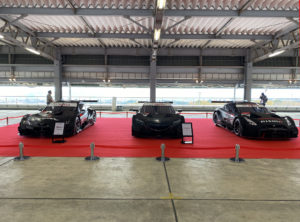 The engine is also a topic for the new generation of GT500 cars, which got unveiled back in September at Suzuka. The Toyota GR Supra, the new FR version of the Honda NSX-GT as well as the updated Nissan GT-R NISMO GT500 were also on display during the Dream Race weekend at Fuji Speedway. Until this year, all manufacturers were allowed to continue their engine development during the middle of the season. However, with the introduction of the Class 1 + α regulations, said development will be frozen: “Next year, the teams are still allowed to change the engine in the middle of the season. However, development will be frozen and they won’t be allowed to bring any updates. So, until the end of this year, the manufacturers have to send their specifications to the GTA for 2020.” It’s unclear, if they will be allowed to work on upgrades for the 2021 season. “We first have to talk with the ITR about that”, Masaaki Bandoh stated.
The engine is also a topic for the new generation of GT500 cars, which got unveiled back in September at Suzuka. The Toyota GR Supra, the new FR version of the Honda NSX-GT as well as the updated Nissan GT-R NISMO GT500 were also on display during the Dream Race weekend at Fuji Speedway. Until this year, all manufacturers were allowed to continue their engine development during the middle of the season. However, with the introduction of the Class 1 + α regulations, said development will be frozen: “Next year, the teams are still allowed to change the engine in the middle of the season. However, development will be frozen and they won’t be allowed to bring any updates. So, until the end of this year, the manufacturers have to send their specifications to the GTA for 2020.” It’s unclear, if they will be allowed to work on upgrades for the 2021 season. “We first have to talk with the ITR about that”, Masaaki Bandoh stated.
Next to the frozen engine development as well as further aerodynamical restrictions underneath the design line (only the flick box, which is the corner part of the front bumper as well as the so-called elephant foot, which is the rear side of the front tyre, allow for free development compared to the current generation GT500 cars) the list of common parts used in next year’s machines increases. Some of those parts like the Acceleration Sensor, Power Box or Engine Control Unit (ECU) will be delivered by Bosch, who also signed an official sponsorship deal with Super GT, with their logo appearing on the upper part of the windshield. Until now, the ECU was provided by Cosworth. 2018 GT500 champion Naoki Yamamoto explained to us that the new Engine Control Unit reacts a bit differently and with a slight delay when shifting, which is something he still has to get used to.
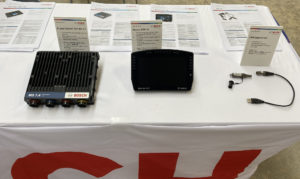 Other common parts include the suspension and all its units such as the upright. “The German company manufacturing these components for DTM cannot also do it for all 15 GT500 cars, which is why we’re making them in Japan, using the same design”, Masaaki Bandoh elaborates. The components are classified as EB and SB parts. While the latter are designed by the Japanese manufacturers based on specific specifications, the EB parts are components such as the monocoque or gearbox and must be used in all cars. Ahead of the first shakedown of the new vehicles, some teams expressed concerns about the new suspension including the upright, if it would be capable to withstand the load of the GT500 tyres, since they were originally designed for DTM’s control rubber. After the first tests, Masaaki Bandoh is putting those concerns aside: “The new cars already ran for over 9000 km without any major problems. At Fuji Speedway, the lap times were already in the 1:28s too.”
Other common parts include the suspension and all its units such as the upright. “The German company manufacturing these components for DTM cannot also do it for all 15 GT500 cars, which is why we’re making them in Japan, using the same design”, Masaaki Bandoh elaborates. The components are classified as EB and SB parts. While the latter are designed by the Japanese manufacturers based on specific specifications, the EB parts are components such as the monocoque or gearbox and must be used in all cars. Ahead of the first shakedown of the new vehicles, some teams expressed concerns about the new suspension including the upright, if it would be capable to withstand the load of the GT500 tyres, since they were originally designed for DTM’s control rubber. After the first tests, Masaaki Bandoh is putting those concerns aside: “The new cars already ran for over 9000 km without any major problems. At Fuji Speedway, the lap times were already in the 1:28s too.”
Super GT’s position in Japan takes priority
 Next year, Super GT will see two international championship rounds for the first time. “It’s going to be hot”, said Masaaki Bandoh while laughing when asked about his expectations for the first ever night race, when the series returns to Sepang, Malaysia next summer. “Since the race is in a hot period, the temperatures at night should be better for both the teams as well as the spectators. We’re currently working on making the drivers more recognizable for the fans. We also want to make the number of the cars more visible with lights.” The first Super GT race in Malaysia since 2013 is planned as a big festival. “The fans can come to the circuit not just to enjoy the race itself. There will be concerts and more, which is a first for us as well.” Despite the two flyaway rounds and interest from other Southeast Asian countries in the past such as Singapore, Masaaki Bandoh doesn’t want to follow DTM’s route by expanding too much: “We first have to think about the position of Super GT in Japan. Additionally, we have to think about the logistical problems, which is why we cannot increase the number of events without any limits. Furthermore, some teams are also taking part in Super Taikyu and Super Formula and thus don’t have any days off, so we have to think about the overall calendars as well.”
Next year, Super GT will see two international championship rounds for the first time. “It’s going to be hot”, said Masaaki Bandoh while laughing when asked about his expectations for the first ever night race, when the series returns to Sepang, Malaysia next summer. “Since the race is in a hot period, the temperatures at night should be better for both the teams as well as the spectators. We’re currently working on making the drivers more recognizable for the fans. We also want to make the number of the cars more visible with lights.” The first Super GT race in Malaysia since 2013 is planned as a big festival. “The fans can come to the circuit not just to enjoy the race itself. There will be concerts and more, which is a first for us as well.” Despite the two flyaway rounds and interest from other Southeast Asian countries in the past such as Singapore, Masaaki Bandoh doesn’t want to follow DTM’s route by expanding too much: “We first have to think about the position of Super GT in Japan. Additionally, we have to think about the logistical problems, which is why we cannot increase the number of events without any limits. Furthermore, some teams are also taking part in Super Taikyu and Super Formula and thus don’t have any days off, so we have to think about the overall calendars as well.”
Not just the collaboration with DTM, but also the increase in English-speaking broadcasts has helped Super GT to gain a bigger popularity throughout the world in recent years. However, when the 2019 season went underway in heavy rain conditions at Okayama, the screens outside of Japan stayed black. The GTA quickly found a new partner in Malaysia-based Haro Sports & Entertainment, the same company that is also promoting the night race in Malaysia, who acquired the rights to distribute the international broadcast rights. “Haro Sports wants to distribute their own events in Malaysia and the rest of the world, that is why they approached us”, Masaaki Bandoh explained. With Motorsport TV, Haro Sports & Entertainment found a new broadcasting partner, demanding that all rounds of the 2019 season had to be streamed for free and not behind a paywall. It’s unclear if this deal will see any changes for the upcoming year. “Obviously, we cannot talk about our contract with Haro Sports”, Masaaki Bandoh said. “In Japan we’re working with J SPORTS, but for the rest of the world, Haro Sports & Entertainment is distributing the broadcast rights.”
GTA chairman Masaaki Bandoh has a clear vision of Super GT’s future. One he is trying to achieve after he finally made his dream of a joint event together with DTM a reality. And with the new generation of GT500 cars, exciting events such as the night race at Sepang as well as the prospect of more Dream Races, the future of Super GT certainly shines brighter than ever. Both in Japan and in the rest of the world.
Copyright Photos: GTA, ITR, Own Archive

